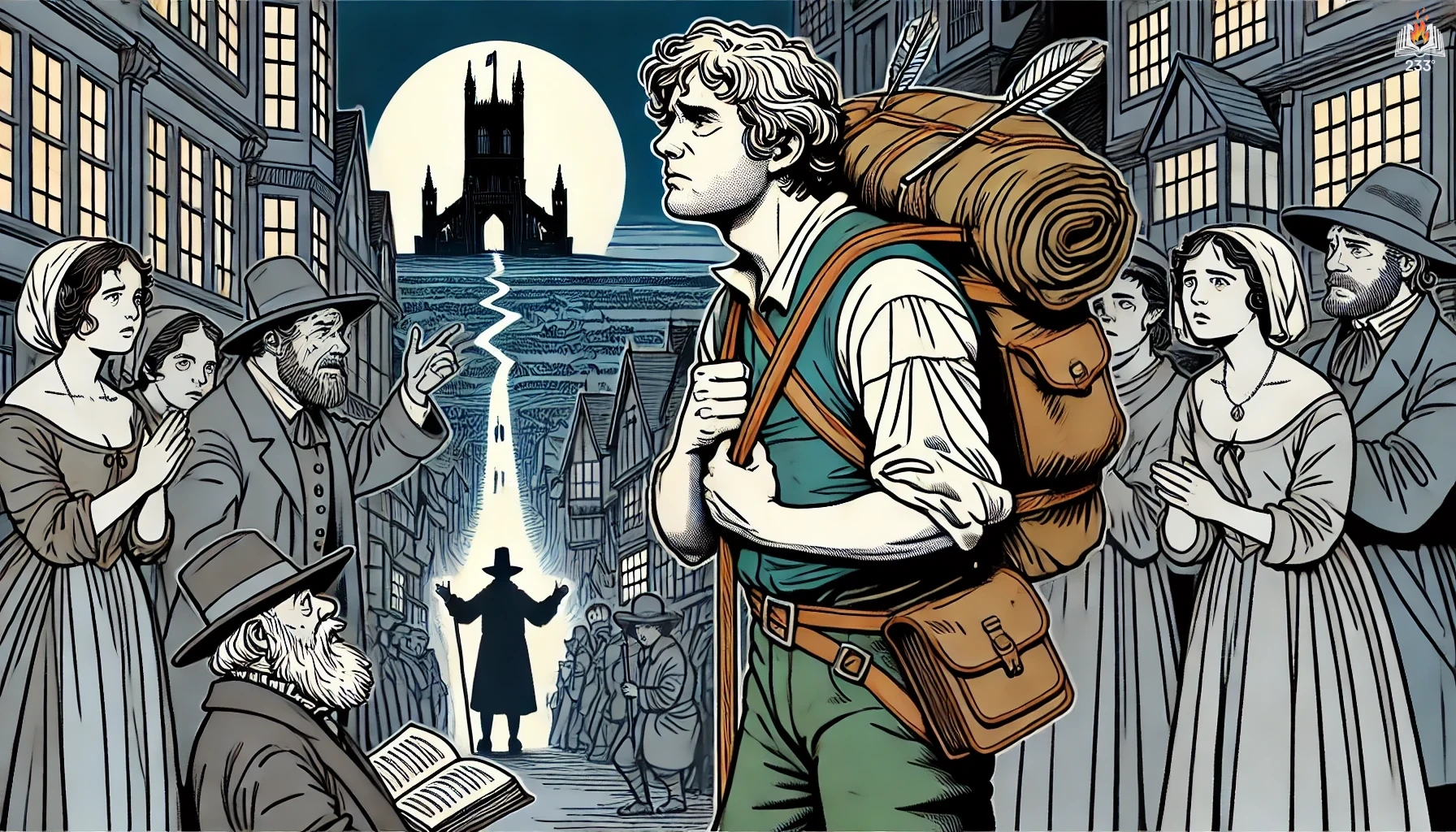Player Piano by Kurt Vonnegut, published in 1952, is Vonnegut’s debut novel and a foundational work in American dystopian fiction. Set in a near-future America transformed by automation, the novel imagines a society where machines have displaced human workers, creating a rigid class divide between the managerial elite and the disenfranchised masses. Though not officially part of a series, Player Piano anticipates themes Vonnegut would continue to explore throughout his career.
Plot Summary
In Ilium, New York, the hum of machines drowns the whispers of human labor. Across the river, Homestead lies in quiet defeat, its people displaced by the great march of automation. Paul Proteus, manager of the Ilium Works and son of the late, legendary George Proteus, presides over this glittering empire of steel and circuits. Paul has everything a man should want – a sharp mind, a respected position, and a wife, Anita, who knows how to climb the social ladder with charm and calculation. Yet within Paul stirs a restlessness, a suspicion that the world of blinking lights and whirring gears has lost something essential.
Paul’s disquiet deepens when his old friend, Ed Finnerty, returns from Washington. Finnerty, once a brilliant engineer at Ilium, has left his government post without explanation. Rumors swirl. Some say he is cracking under pressure, others whisper rebellion. Finnerty’s presence electrifies Paul’s life, stirring the discontent he has tried to suppress. Anita disapproves. She wants Paul to please his superiors, to secure the prestigious Pittsburgh post vacated by death, but Paul’s thoughts drift elsewhere – to questions of meaning, to the lives left crumpled on the other side of the river.
Among those lives is Rudy Hertz, an old machinist whose expert hands once guided the lathes now governed by magnetic tape. Paul remembers the day he and Finnerty recorded Rudy’s motions for the master tape – the same tape that renders Rudy obsolete. Rudy lingers in Homestead’s saloons, a ghost of usefulness, raising a glass to memories no longer shared by the world around him. When Paul crosses the river to fetch Irish whiskey for Finnerty, he stumbles into Rudy’s crumbling orbit. The old man’s pride, his desperate attachment to past glories, rattles Paul, awakening the guilt he keeps beneath his polished exterior.
The machines hum along, indifferent.
Meanwhile, Reverend James Lasher, a former minister with the charisma of a born leader, gathers the displaced in Homestead. His voice carries hope, fury, and the promise of rebellion. Paul meets Lasher through Finnerty and listens to his talk of human dignity, of a world where men matter more than mechanisms. Paul’s inner walls begin to crack. At the same time, the Shah of Bratpuhr, a foreign dignitary, tours America, his dark, piercing eyes glimpsing the absurdity beneath the glittering machinery. Through his translator, the Shah watches men idle in the streets and calls them slaves, though polite officials correct him: they are citizens. Still, his gaze misses nothing.
Pressure mounts on Paul. Anita urges him to make the right impression on Kroner and Baer, the Eastern Division’s top men, who hold the keys to Pittsburgh. Paul smiles, gives the speeches, drinks the cocktails, but each gesture leaves a bitter aftertaste. When Finnerty refuses to play along, when he flaunts his rumpled suit and rebellious charm before the management elite, Paul feels the stirrings of his own defiance rise.
Lasher’s movement grows. Paul learns of the Ghost Shirt Society, a secret group bent on uprising. Drawn to their cause but unsure of his courage, Paul hesitates at the edge of rebellion. He stands between two worlds – the sterile, mechanical one where Anita thrives and the messy, unpredictable human world Lasher defends. A meeting of the Society draws Paul deeper, and soon the factory’s heart feels less like home and more like prison.
Tensions explode when Finnerty, Paul, Lasher, and the rebels sabotage the machines, smashing the symbols of oppression. The riots ripple across Ilium. Paul, swept by the momentum, surrenders his identity as company man. But the rebellion falters. The machines, so easily broken, are just as easily repaired. The human spirit, once uncaged, finds itself cornered.
Paul is arrested. In prison, stripped of titles and privileges, he encounters Lasher once more. The two men speak quietly, their revolution crumbled, their dreams reduced to the soft shuffle of feet in a cellblock. Paul feels no regret, only a bittersweet calm, as though he has finally stepped into his own life.
Anita, ever resourceful, leverages her charm and influence to have Paul released. Yet when the gate opens, Paul knows the cost. Freedom, in this world, is permission to return to the machine. He walks away from Anita, from the life so carefully crafted for him, toward a horizon dimmed but not extinguished. Outside, the machines continue their endless dance, indifferent to rebellion, to love, to sacrifice.
Above the city, the Shah of Bratpuhr prepares to leave. He has seen the marvels of the West, the chrome and circuitry, the flawless efficiency. He has also seen the hollow eyes of men with nothing to do. As his limousine pulls away, the Shah whispers a blessing over the land of the player piano, where the music plays on without the touch of human hands.
Main Characters
Doctor Paul Proteus: Paul is the protagonist, a brilliant and conflicted manager at the Ilium Works. Despite his privileged position, he grows increasingly disillusioned with the mechanized world and its social consequences. His internal struggle drives the plot, as he wrestles with guilt, loyalty, and the desire for rebellion.
Anita Proteus: Anita, Paul’s ambitious and image-conscious wife, craves social status and stability. She is emblematic of the managerial class’s attachment to power and plays a significant role in pressuring Paul to conform, revealing the personal cost of societal expectations.
Doctor Edward Finnerty: A gifted engineer and Paul’s old friend, Finnerty is rebellious, eccentric, and restless. Disenchanted with the system, Finnerty becomes a catalyst for Paul’s awakening, representing the intellectual’s struggle against a dehumanizing technocracy.
Reverend James Lasher: Lasher is a former minister and passionate leader of the working-class rebellion. His moral authority and charisma offer the disenfranchised a voice, and his revolutionary zeal challenges Paul to rethink his role in society.
Rudy Hertz: A humble, aging machinist whose skills were once valued but are now obsolete. Rudy embodies the tragedy of human displacement by automation, and his fate haunts Paul’s conscience.
Theme
Automation and Dehumanization: The novel explores the displacement of workers by machines, reflecting postwar anxieties about automation. Vonnegut critiques a society that values efficiency over humanity, showing how people become redundant in the face of technological progress.
Class Division and Social Stratification: A rigid hierarchy separates the privileged engineers and managers from the powerless masses. This theme underscores the social cost of progress, exposing the loss of dignity and purpose among the working class.
Individual vs. System: Paul’s personal conflict represents the universal struggle between individuality and conformity. Vonnegut examines the psychological toll of living under an all-encompassing system, highlighting the price of rebellion and the seduction of comfort.
Illusion of Progress: Through the metaphor of the player piano—music mechanically reproduced without human touch—Vonnegut suggests that technological “progress” often strips life of meaning and creativity. The mechanized world becomes a hollow spectacle, alienating its creators.
Writing Style and Tone
Kurt Vonnegut’s writing in Player Piano is marked by sharp wit, irony, and black humor. His prose is accessible yet layered with satire, blending colloquial dialogue with precise, almost clinical descriptions of machines and industrial processes. Vonnegut’s language often slips between the mundane and the absurd, creating a tone that oscillates between playful mockery and deep melancholy.
The tone of Player Piano is both satirical and elegiac. Vonnegut deftly skewers corporate and bureaucratic culture, poking fun at its absurdities, while simultaneously mourning the loss of human connection and purpose. This dual tone invites the reader to laugh at the tragic absurdities of modern life while reflecting on their sobering implications. His narrative voice is compassionate yet unsparing, offering both critique and empathy in equal measure.
We hope this summary has sparked your interest and would appreciate you following Celsius 233 on social media:
There’s a treasure trove of other fascinating book summaries waiting for you. Check out our collection of stories that inspire, thrill, and provoke thought, just like this one by checking out the Book Shelf or the Library
Remember, while our summaries capture the essence, they can never replace the full experience of reading the book. If this summary intrigued you, consider diving into the complete story – buy the book and immerse yourself in the author’s original work.
If you want to request a book summary, click here.
When Saurabh is not working/watching football/reading books/traveling, you can reach him via Twitter/X, LinkedIn, or Threads
Restart reading!








